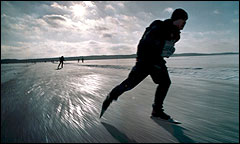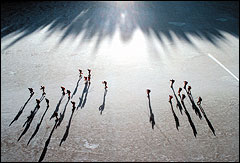
Thursday, January 17, 2002
By JIM HEINTZ
THE ASSOCIATED PRESS
MORA, Sweden -- If someone in Mora suggests putting on ice skates and going once around the rink, take along a lunch. It's a 15-mile venture.
The rink, a path cleared through the snow on the ice of Lake Orsa on the edge of town, is one of the country's prime spots for devotees of the idiosyncratic Swedish form of ice skating, which is starting to attract foreign visitors.
 |
|
| A skater in the long-distance Vikingarännet puts the miles behind him with the help of 20-inch-long skates. FREDRIK FUNCK/1999 |
In Swedish it's called "långfärdskridskoåkning," but foreigners who don't want to tackle that mound of syllables usually call it Swedish or Nordic skating. It requires both grace and grit, and those who have plenty of both have been known to rack up more than 60 miles in a day.
There are no toe loops or triple axels in this skating, and none of the aggression or quick footwork of hockey. It's more like a form of moving meditation -- a near-silent glide for hours past white-cloaked hills, red wooden cabins and dense forests of pine.
However pastoral the experience, the skates look like brutal weapons: blades nearly 2 feet long that strap to telemark ski boots. Because the blades project far out in front, the skater can't raise his foot with the toe pointed downward as in figure skating or hockey - and the first-timer feels as if he's wearing clown shoes.
It's also unsettling at first that the blades are flat, unlike curved figure skates and hockey skates. So there's no "sweet spot" and the best balance is found by leaning back a bit on the heels - directly opposed to instinct's call to lean forward.
But these peculiarities can be mastered in a couple of hours of stumbling, and the clumsy duffer is transformed: hands go down and head goes up so eyes can take in the calming vistas of the countryside. Veteran skaters often clasp their hands behind their backs and from a distance they resemble contemplative philosophers as they cruise along.
A sharp-tongued friend once joked that this sort of skating was a perfect fit for the stereotypically taciturn Swedes: "It's a way for them to be cold, lonely and not talk all day." Perhaps a variation is more accurate: Sweden is perfect for skating. Not only are the winters long, but there's an abundance of water to freeze.
 |
|
| Miles to go before they rest: Using ski poles to aid in balance and stride, competitors in the annual 50-mile Vikingarännet cruise along an ancient Viking route from Uppsala to Stockholm. PETER HOELSTAD/2001 |
About 9 percent of Sweden's territory is water. Skeins of lakes and rivers run through the land, looking like the dark streaks in marble - especially in a winter that produces "black ice," the skater's dream. Swept free of snow by the wind, such ice is so dense that it absorbs light.
This is a combination longed for by the Dutch, a nation of skating fanatics frustrated by a long string of warm winters. Dutch skaters have begun coming to Sweden in droves every winter to live out their Hans Brinker fantasies and in 2002 the "Dutch Marathon Championship" will be held on Lake Orsa.
Dutch skaters also come for the mass skating events in February that attract as many as 4,000 people, including the 62-mile Siljanskrinnet in Mora and the country's most famous skating tour, the 50-mile Vikingarännet, which follows an ancient Viking route from Uppsala to Stockholm.
They are a study in contrasts with most Swedish skaters. The Dutch come with sleek clap-style speedskates and body-hugging suits of high-tech fabric, intent on getting from point to point as fast as possible. The Swedes, although some have been seduced by that approach, prefer the clunkier skates, wrap themselves in jackets that make them look as bulky as bears and hold a measured pace.
While the Dutch speed along, Swedes often break up their skating day with a picnic on the ice. Many bring their dogs with them or even tow infants on sledges; being flashy seems to go against the Swedish grain.
But while the Swedes don't show off, Americans are nevertheless starting to take notice of the sport. At the 2001 Siljanskrinnet there was one American participant; for 2002, an American operator is arranging a package tour.
EVENTS: Vikingarännet, which can be done in 50-mile or 30-mile runs, takes place Feb. 10. It begins in Uppsala and organizers arrange transportation from Stockholm for participants.
Mora, a four-hour train ride from Stockholm, holds a full week of skating events, including Siljanskrinnet, beginning Feb. 3. The events have distances ranging from 15 to 120 miles.
Krogrännet, an 18-mile run that ends at a famous Stockholm waterside "krog" (tavern), is scheduled for Feb. 3.
OTHER SKATING OPPORTUNITIES: Many communities plow tracks on their frozen lakes. In Stockholm, the Hellasgården park in the southern suburbs has an especially scenic track, along with a sauna and a restaurant. Brunnsviken, on the northern edge of downtown, usually freezes smoothly, and skating along takes one past an imposing royal park and high cliffs.
Regional outdoor societies (Friluftsfrämjandet) organize weekend group skates for all skill levels.
EQUIPMENT: Rentals are available at Hellasgården and at the Stockholm sports store Cykelstället. Rental opportunities elsewhere may be thin.
Along with the conventional boot-and-skate outfit, blades that fit Salomon-binding cross-country boots and hiking boots can be purchased. The latter are convenient, but such boots often don't provide sufficient ankle support for satisfactory skating.
ON THE WEB:
Vikingarännet site: www.vikingarannet.com
Krogrännet: www.krogrannet.nu
Siljanskrinnet and other events in Mora: www.vasaloppet.se/skridskoveckan